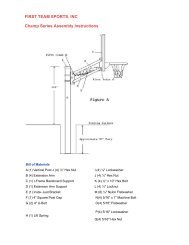Owners Manua - BBQ Grills
Owners Manua - BBQ Grills
Owners Manua - BBQ Grills
Create successful ePaper yourself
Turn your PDF publications into a flip-book with our unique Google optimized e-Paper software.
Question:<br />
The Regulator and Hose supplied with my gas grill<br />
does not fit the older LP Gas tank I’ve used for years.<br />
Why not?<br />
Answer:<br />
The U.S. Government regulates gas appliances and LP<br />
Gas tanks. When regulations are changed the LP Gas<br />
tank fittings are altered to insure compliance. If your LP<br />
Gas tank does not fit the Regulator and Hose supplied<br />
with your new grill, the tank is outdated and must be<br />
replaced. Note: Effective April 1, 2002 all LP Gas tanks<br />
sold must include an “OPD” Overfill Prevention Device.<br />
The OPD tanks are identified by their triangular-shaped<br />
valve wheel. This internal device prevents the LP Gas<br />
tank from being overfilled. Tanks without an OPD valve<br />
can not be refilled.<br />
Question:<br />
What causes grill parts to rust and what effect does<br />
it have on my grill?<br />
Answer:<br />
Rusting is a natural oxidation process and will not affect<br />
the short term performance of your grill.<br />
To slow the rusting process on Cooking Grids we<br />
recommend greasing the grids before and after each<br />
cookout. Use a brush to apply a thin layer of cooking oil or<br />
vegetable shortening onto each grid. We do not suggest<br />
spray type oils unless they are specified for hightemperature<br />
cooking. If your Cooking Grids are Porcelain<br />
coated, be sure to coat the entire cooking surface including<br />
edges and any areas with chipped porcelain.<br />
Routine care and maintenance is required to preserve the<br />
appearance and corrosion resistance of stainless steel.<br />
The fact is stainless steel can corrode, rust and discolor<br />
under certain conditions. Rust is caused when regular steel<br />
particles in the atmosphere become attached to the stainless<br />
steel surface. Steel particles can also become attached<br />
to your grill if you use steel wool or stiff wire brushes to<br />
clean the grill instead of non-abrasive cloth, sponge or nylon<br />
cleaning tools. In coastal areas rust pits can develop on<br />
stainless surfaces that cannot be fully removed. Bleach<br />
and other chlorine based solutions used for household<br />
and pool cleaning can also cause corrosion to stainless<br />
steel.<br />
Weathering, extreme heat, smoke from cooking and machine<br />
oils used in the manufacturing process of stainless<br />
steel can cause stainless steel to turn tan in color. Although<br />
there are many factors which can affect the surface appearance<br />
of stainless steel, they do not affect the integrity of the<br />
steel or the performance of the grill. To help maintain the<br />
finish of stainless steel follow these cleaning procedures<br />
for the best results:<br />
A-6<br />
After every use (after your grill has cooled down), wipe<br />
stainless surfaces with a soft, soapy cloth or sponge<br />
then rinse with water. Be sure to remove all food particles,<br />
sauces or marinades from stainless steel because<br />
these can be highly acidic and damaging to stainless<br />
surfaces.<br />
Never use abrasive cleaners, scrubbers or stiff wire<br />
brushes of any type on your grill.<br />
Use a heat resistant Stainless Steel Cleaner and rub or<br />
wipe in the direction of the stainless steel grain or polish<br />
lines. Do not polish against the grain.<br />
FREQUENTLY ASKED QUESTIONS (FAQ'S)




